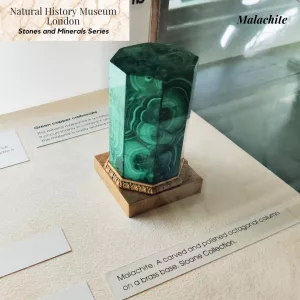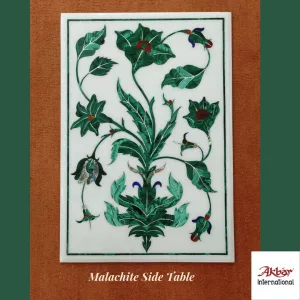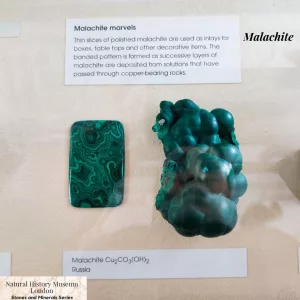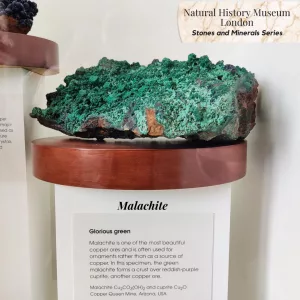This website uses cookies so that we can provide you with the best user experience possible. Cookie information is stored in your browser and performs functions such as recognising you when you return to our website and helping our team to understand which sections of the website you find most interesting and useful.
Geographic Origin
Malachite, a captivating semi-precious stone, traces its origins to diverse geological landscapes around the globe. Notable deposits are found in Russia, the Democratic Republic of Congo, Zambia, Mexico, Australia, and the United States. The geological conditions in these regions, particularly in copper-rich environments, foster the formation of malachite crystals.

Physical Characteristics and Chemical Composition
Malachite, scientifically known as copper carbonate hydroxide, is renowned for its lush green hues and distinctive patterns. Its chemical formula is Cu2CO3(OH)2. The green color arises from the presence of copper ions within the crystal lattice. The mineral often forms in botryoidal or fibrous masses, and its characteristic banding or concentric patterns add to its allure.
High-quality malachite exhibits a vibrant, even green color with well-defined patterns and a smooth, polished surface. In contrast, low-quality malachite may display dullness, uneven color distribution, and a lack of distinct banding. Impurities or inclusions can also affect its appearance.

Identifying High and Low-Quality Malachite
Distinguishing between high and low-quality malachite involves considering factors like color, patterns, and texture. High-quality malachite typically displays a deep, saturated green color with well-defined concentric bands. The patterns should be intricate and harmonious. A polished surface should reveal a silky luster, enhancing its visual appeal. In contrast, low-quality malachite may appear faded, lack distinct patterns, and exhibit a less appealing texture.

Uses in Jewelry and Other Areas
Malachite’s aesthetic appeal makes it a popular choice in the world of jewelry. Artisans carve it into beads, cabochons, and intricate shapes for use in rings, earrings, necklaces, and bracelets. Due to its relative softness, malachite allows for detailed carving and intricate designs.
Beyond jewelry, malachite finds application in decorative art, sculptures, and inlay work. Its striking appearance makes it a sought-after material for creating ornamental pieces. Notable examples of malachite usage include the magnificent malachite room in the Winter Palace of St. Petersburg, Russia, and the Malachite Pavilion in the Summer Palace of Beijing, China.

Malachite in Indian Parchinkari Artform
In India, malachite has been incorporated into the intricate art of Parchinkari, a traditional form of decorative inlay work. Skilled artisans embed malachite pieces into marble surfaces, creating stunning patterns and designs. This art form has been used in the construction of historical monuments like the Taj Mahal, where malachite inlay work adds a touch of opulence to the pristine white marble.
Astrological and Feng Shui Properties
Malachite is associated with various astrological and feng shui properties. It is often linked to zodiac signs such as Taurus, Capricorn, and Scorpio, believed to bring balance, prosperity, and positive energy to individuals born under these signs.
In feng shui, malachite is valued for its ability to absorb negative energy and promote emotional healing. Placing malachite in specific areas of a living space is believed to enhance positive energy flow and create a harmonious environment. The stone’s lush green color aligns with the Wood element, symbolizing growth, renewal, and vitality.
In conclusion, malachite stands as a testament to the beauty and diversity of nature’s creations. From its geological origins to its applications in art and metaphysics, malachite continues to captivate and inspire, showcasing the intricate interplay of color, form, and cultural significance.
